If you’re planning on creating a new lawn, you have two choices.
You can;
But which is best, grass seed or turf?
In this article, we’re going to take a deep dive into this question, discuss the pros and cons of each and hopefully, help you decide between turf or seed.
NOTE: No matter which you decide to use, it’s imperative that you prepare the ground properly before laying turf or sowing seed.
If you fail to do this correctly, then it really doesn’t matter what you use. The results will be disappointing.
The Pros and Cons of Using Turf
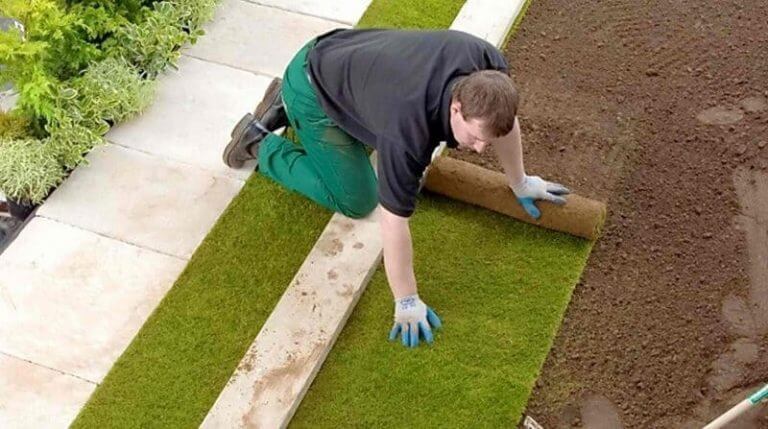
Firstly, let’s take a look at the advantages and disadvantages of laying turf.
The Advantages of Laying Turf
Laying turf has several advantages over sowing seed;
- Laying turf is quick and easy
- You can lay turf practically any time of the year
- Turf creates visual appeal almost instantly
- It doesn’t wash off slopes
- You can use your lawn sooner
Laying Turf is Quick and Easy
Once the ground has been prepared, laying turf is really easy.
It’s quick too.
No matter if you do it yourself or get a landscaper to do it for you, you can create large areas of lawn in a fairly short period of time.
Also, a newly turfed lawn is easy to care for when compared to a newly seeded lawn.
You Can Lay Turf Practically Any Time of the Year
The best time to lay turf is in the autumn.
This is because the soil is warm from the heat of the summer, there’s still plenty of sunlight and the rain provides vital water.
But despite that, you can lay turf at any time of the year. As long as you can provide water, the rest will take care of itself.
Turf Creates Visual Appeal Almost Instantly
Lawns create a sense of structure in a garden and when you lay turf, you create that structure almost instantly.
Also, your lawn will be green from day one.
Over a few days, the grass will grow and the turves will knit together, further improving its appearance.
Turf Doesn’t Wash Off Slopes
Creating lawns on slopes or banked areas is much easier with turf.
As the turf starts to grow roots, it holds itself in place and doesn’t move.
Grass seed takes time to germinate and it’s easily washed off slopes in the rain or if you water it too heavily.
You Can Use a Turfed Lawn Sooner
Turfed lawns take a matter of weeks to fully establish. As a result, so you can use your lawn within a relatively short period of time.
A lawn made from grass seed can take months to establish. In some cases, it can take over a year.
When you buy turf, you’re essentially buying time.
The Disadvantages of Turf
Of course, turf has its disadvantages too;
- The cost of turf is expensive when compared to grass seed
- Limited types of turf to choose from
- Turf is perishable
Turf is Expensive When Compared to Grass Seed
The biggest disadvantage of turf is the cost.
To illustrate this I’ll use Rolawn’s turf calculator.
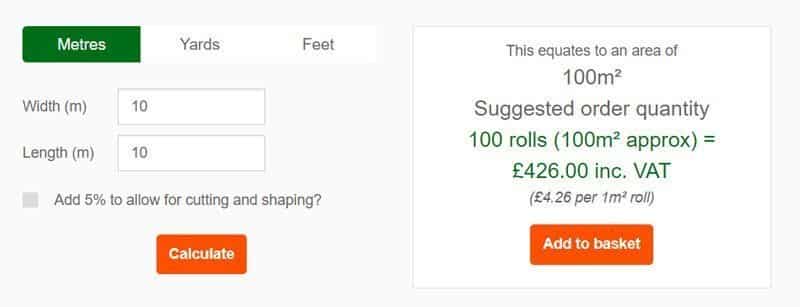
100sq meters of turf will cost you £426.
Compare that to the cost of grass seed to cover the same area. It’s just £62.85;
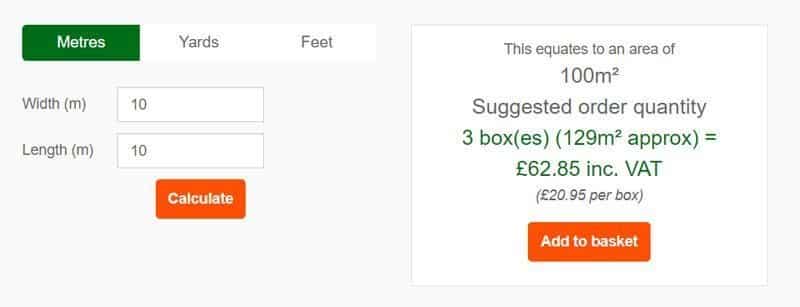
In this case, turf is nearly seven times more expensive.
Depending on the turf you buy and the supplier you buy it from, this can easily be much higher.
Limited Types of Turf to Choose From
If you want to create the ‘perfect lawn’ it needs to contain grasses that are suited to the conditions in which it will grow, as well as its intended use.
However, the perfect lawn means different things to different people.
For example, if your lawn is covered by shade, it’ll need to contain grasses that cope well in cooler, damper conditions.
On the other hand, if your lawn gets sun all day, it’ll need to contain grasses that can cope in the dry heat.
Then you need need to think about how you’ll use your lawn and how you want it to look.
If it’s going to get hammered by the kids playing on it, it’ll need hard-wearing grasses that’ll cope with the stress.
Or, if you want to create a formal masterpiece or bowling green type of lawn, then again, it’ll need to contain grasses that grow slowly and cope with close mowing.
And then there’s the type of soil you need to consider.
Is it sandy, loamy, clay, acidic or alkaline?
Turf production is an incredibly expensive business and as such, suppliers can’t possibly afford to create so many different types of turf.
Instead, they try to create an ‘all rounder’. Something that’ll do ok in most conditions.
This type of turf typically contains a mixture of ryegrass and fescues.
If your lawns resides in shade, you’ll struggle to find turf. Sowing seed is your only option.
You can buy turf for formal or ornamental lawns but you’ll need to search for the right supplier. You’ll also pay a premium for it.
Turf is Perishable
If you leave turf to sit there without laying it, it’ll degrade and start to die very quickly.
As such, you should only order your turf once you have prepared the ground.
Because turf goes off very quickly, you’ll want to lay it as soon as it arrives. This means choosing a day when the weather is on your side.
If it’s too hot, the turf can quickly dry out. If it’s too wet you’ll not be able to lay it.
If possible, choose a cool, overcast day for delivery and lay the turf as soon as it arrives.
The Pros and Cons of Using Grass Seed
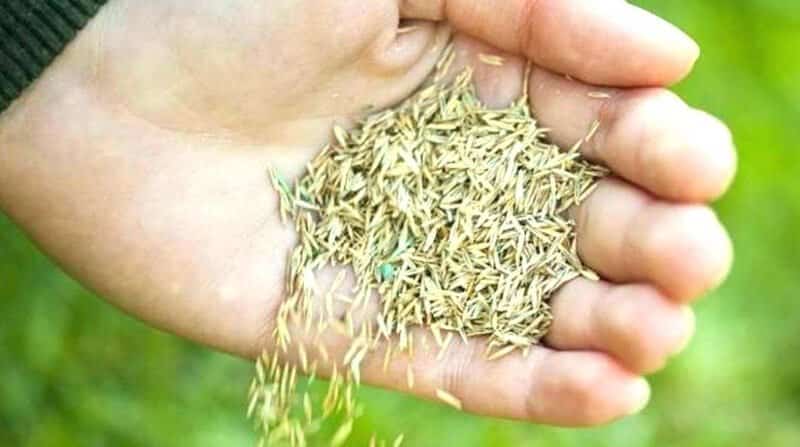
Now we know the pros and cons of using turf, let’s take a look at grass seed.
The Advantages of Sowing Grass Seed
There are lots of advantages to using grass seed over turf;
- Grass seed is much cheaper than turf
- There are lots of grass seed blends to choose from
- Spreading grass seed is quicker than laying turf
- You can store grass seed until you’re ready to use it
- Excess grass seed can be stored and used for repairs
Grass Seed is Much Cheaper than Turf
I’ve already covered this but it bears repeating.
Buying grass seed is at least seven times cheaper than buying turf. When compared to ornamental turf, grass seed can be more than ten times cheaper.
There Are Lots of Grass Seed Blends to Choose From
Unlike turf which is very limited in choice, there are hundreds of different grass seed mixes to choose from.
With a little bit of research, you can often find the perfect blend of grass seed to suit the environmental and climatic conditions in your garden.
If your lawn sits in shade, choose a shady lawn seed blend.
Or do you want an ornamental lawn? If so, choose a seed mix that contains slow-growing grasses that’ll cope with close mowing.
Do you have kids and pets who spend their days playing on the lawn? Then choose a hard-wearing mix.
Or do you want a lawn that looks nice, will cope with wear and grows well in partial sun or shade? In this case, a multi-purpose lawn seed will be the best choice.
To help you choose the best grass seed for you can your lawn, read my guide: Best Grass Seed UK: Reviews of My Top 5 Picks (and 2 to Avoid).
Spreading Grass Seed is Quicker Than Laying Turf
The actual sowing of grass seed is quicker than laying turf.
Although fairly quick, laying turf is a laborious process that involves laying one square meter at a time.
However, spreading seed takes no time at all, especially when you use a spreader. You can sow hundreds of square meters in just a few minutes.
You Can Store Grass Seed Until You’re Ready to Use it
Unlike turf, which you need to lay as soon as it’s delivered, you can store grass seed until you’re ready to use it.
This means you can wait for the perfect conditions in which to sow your new lawn without worrying about it perishing.
You Can Use Excess Grass Seed For Maintenance and Repairs
When you use grass seed to create a new lawn, the odds of you have some leftover are high.
When you store grass seed properly, you can keep it for several years. So you can use it to overseed your lawn in the spring and autumn.
It’s also vital that you overseed after invasive treatments the removal of lawn moss, scarification and lawn aeration.
Overseeding with the same blend of grass seed that you created the lawn with in the first place is the perfect scenario. It keeps the look of your lawn completely consistent over time.
The Disadvantages of Sowing Grass Seed
Just like turfing, sowing grass seed has its disadvantages too;
- It can take up to 12 months for your lawn to fully establish
- Germination is often slow and often patchy
- Animals can destroy your new lawn as it grows
- You’ll have a constant battle with weeds
- A lawn sown from seed needs much more aftercare than turf
It Can Take Up to 12 Months For Your Lawn to Fully Establish
Sowing a lawn from seed takes far longer than turfing.
Turf typically takes 8-12 weeks to take root and fully establish itself to the point where the lawn becomes useable.
Grass seed, on the other hand, can take up to a year.
Germination is Slow and Often Patchy
In many cases, germination can take up to 4 weeks, depending on the weather and other conditions. Germination will slow down in cooler weather.
You’ll probably also find that grass seed doesn’t germinate in all areas and you’ll find you have bare patches which you need to seed again.
Animals Can Destroy You New Lawn as it Grows
Birds and other animals love grass seed and will happily roam the area in which you have sown it eat it.
You’ll probably also find that the neighbourhoods cats will start to use your prepared ground as their toilet.
If you create your new lawn from seed, you’ll need to protect it from birds and other animals.
You’ll Have a Constant Battle With Weeds
This is especially true if you sow a new lawn from seed in the spring.
At this time of year, millions of weeds seeds are spread on the wind and in bird droppings.
Your bare soil is the perfect place for them to settle and germinate and potentially take over the areas before your grass seed has even had a chance to germinate.
So you’ll have to be very vigilant and check the area daily for weeds. You’ll need to pull them out by hand too as the grass seedlings aren’t yet strong enough to be hit with a weed killer.
A Lawn Sown From Seed Needs Much More Aftercare Than Turf
A newly turfed lawn needs regular watering. That’s pretty much it.
However, a lawn sown from seed not only requires more water but you’ll need to deal with everything else I have mentioned.
The weeding, protecting it from animals, re-seeding areas that haven’t germinated etc.
Sowing a lawn from seed requires much more care than laying turf, for a much longer period of time.
So Which is Best, Grass Seed or Turf?
It’s a tough question to answer and very much depends on your situation.
For me personally, I’ll always try to use turf where I can. The extra cost is worth it because it saves me months of work when compared to sowing seed.
Even if I’m creating a formal or putting green type lawn, I’ll always use turf from a company called Rolawn. They produce high-quality turf that has been used in many medal-winning gardens at leading flower shows.
That said, I will use grass seed if I have to.
If I’m creating a lawn in an area that is covered by lots of shade, then I’ll always sow seed.
Turf doesn’t generally perform well in these environments because it doesn’t contain the species of grass that grow best in this situation.
In Summary
For many people, deciding whether grass seed or turf is the best option for creating a new lawn will come down to budget.
As I demonstrated earlier with Rolawn’s turf calculator, 100sq meters of turf weighs in at £426 compared to just £62.85 for the equivalent in grass seed.
That will play a massive part in many people’s decisions.
But as I have already said, when you buy turf, you’re essentially buying time. Your garden will look more complete and it’ll be useable in a much shorter period of time than if you were to sow seed.
In the end, the choice between turf or grass seed is up to you.
Over to You
Are you going to use grass seed or turf to create your lawn?
Or have you already created your lawn? If so, did you use turf or seed and why did you choose one over the other?
Let me know in the comments.
And as always, if you have any questions or queries, leave a comment and I’ll reply as soon as I can.
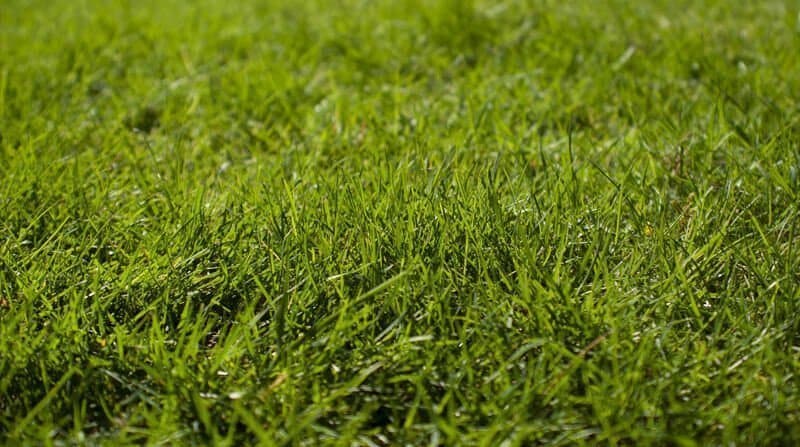

Thank you for your advice regarding turfying a lawn . It was very helpful. I need a quote to turf my lawn .